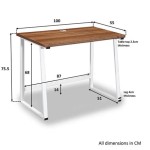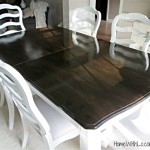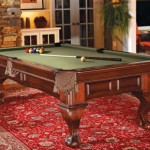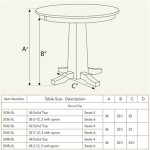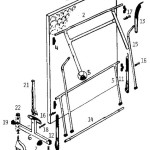The Enduring Charm of the Rustic Farmhouse Dining Table
The rustic farmhouse dining table stands as a cornerstone of the modern home, blending functionality with a unique aesthetic that speaks to simpler times. Characterized by sturdy construction, natural materials, and a weathered, often distressed finish, these tables offer more than just a place to eat; they provide a gathering space that fosters connection and evokes a sense of warmth and comfort. Their popularity stems from their adaptability, seamlessly integrating into various design styles, from the purely rustic to the more eclectic and contemporary.
Understanding the appeal of the rustic farmhouse dining table requires a deeper look into its design elements, construction, and the overall atmosphere it brings to a home. It’s not merely a piece of furniture, but rather a statement that reflects a particular lifestyle – one that values authenticity, community, and the beauty of imperfection.
Key Features Defining a Rustic Farmhouse Dining Table
Several characteristics distinguish a rustic farmhouse dining table from other types of dining tables. These features are not merely stylistic choices; they are integral to the table’s overall functionality, durability, and visual impact. The combination of these elements creates the distinctive charm and enduring appeal that defines the rustic farmhouse aesthetic.
Material Selection: Primarily, these tables are crafted from solid wood, often reclaimed or sourced from sustainable forests. Common wood types include pine, oak, maple, and walnut. The specific wood chosen significantly impacts the table's overall appearance and durability. Pine, for instance, is a softer wood that readily accepts staining and distressing techniques, lending itself well to the farmhouse look. Oak, on the other hand, is a much harder wood, known for its durability and distinctive grain patterns. Reclaimed wood, sourced from old barns, factories, or other structures, adds an element of history and unique character to the table. The imperfections inherent in reclaimed wood, such as nail holes, knots, and variations in color, are considered desirable features that contribute to the table's rustic appeal.
Construction and Design: The construction of a rustic farmhouse dining table typically emphasizes strength and stability. Traditional joinery techniques, such as mortise and tenon joints or dovetail joints, are often employed to ensure the table's longevity. The table's design usually features simple, clean lines with a focus on functionality. Common design elements include thick, solid wood tops, sturdy legs (often turned or trestle-style), and aprons (the horizontal supports that connect the tabletop to the legs). Extension leaves are also a frequent feature, allowing the table to be expanded to accommodate larger gatherings. The overall design is intended to be both aesthetically pleasing and highly functional, providing ample seating and a durable surface for everyday use.
Finish and Distressing: The finish of a rustic farmhouse dining table is crucial to achieving the desired aesthetic. Rather than a perfectly smooth, high-gloss finish, these tables typically feature a matte or satin finish that allows the natural grain of the wood to show through. Distressing techniques, such as sanding, wire brushing, and staining, are often used to create a weathered, aged appearance. These techniques can simulate the wear and tear that a table might experience over decades of use, adding to its character and charm. Chalk paint, milk paint, and stain are popular choices for finishing, as they provide a rustic, slightly imperfect look. The goal is to create a finish that looks both beautiful and durable, highlighting the natural beauty of the wood while showcasing the table's handcrafted nature.
Integrating a Rustic Farmhouse Table into Different Design Styles
One of the most appealing aspects of the rustic farmhouse dining table is its versatility. While it is naturally suited to farmhouse and country-style interiors, it can also be effectively integrated into a variety of other design schemes, adding warmth, character, and a touch of rustic charm to more modern or formal spaces. The key to successful integration lies in understanding how to balance the table's inherent rustic qualities with the other elements in the room.
Farmhouse and Country Styles: In a traditional farmhouse or country-style setting, the rustic farmhouse dining table is a natural fit. It complements the other elements of the room, such as shiplap walls, exposed beams, and vintage accessories, creating a cohesive and welcoming atmosphere. To enhance the farmhouse feel, consider pairing the table with mismatched chairs, a vintage chandelier, and a woven rug. A simple, natural color palette of whites, creams, and muted earth tones will further reinforce the rustic aesthetic. Textiles with floral prints, gingham patterns, or burlap textures can also be used to add visual interest and enhance the overall farmhouse charm.
Modern and Contemporary Styles: Incorporating a rustic farmhouse dining table into a modern or contemporary space requires a more deliberate approach. The contrast between the table's rustic qualities and the clean lines and minimalist aesthetic of modern design can create a striking and visually appealing effect. To achieve this balance, choose a table with simpler lines and a more refined finish. Pair the table with modern chairs in contrasting materials, such as metal or acrylic, to create a juxtaposition of styles. Keep the surrounding decor minimal and uncluttered, focusing on a few key pieces that complement the table's rustic charm. A modern lighting fixture, such as a sleek pendant lamp, can also help to bridge the gap between the rustic and contemporary elements.
Transitional Styles: Transitional design represents a blend of traditional and modern elements, making it an ideal setting for a rustic farmhouse dining table. In a transitional space, the table can serve as a focal point, adding warmth and character to the room while still maintaining a sense of sophistication. To create a cohesive transitional look, balance the table's rustic qualities with more refined elements, such as upholstered chairs, elegant lighting, and a neutral color palette. Accessorize with a mix of traditional and contemporary pieces, such as antique vases, modern artwork, and textured rugs. The key is to create a space that feels both comfortable and stylish, with a harmonious blend of old and new.
Caring for Your Rustic Farmhouse Dining Table
Maintaining the beauty and longevity of a rustic farmhouse dining table requires proper care and attention. The natural materials and often weathered finishes require specific cleaning and maintenance techniques to prevent damage and preserve the table's unique character. Regular cleaning, appropriate protection from spills and heat, and occasional refinishing can help keep your table looking its best for years to come.
Cleaning and Maintenance: Regular cleaning is essential for keeping your rustic farmhouse dining table looking its best. Use a soft, damp cloth to wipe down the table after each use, removing any food residue or spills. Avoid using harsh chemicals or abrasive cleaners, as these can damage the finish and strip away the wood's natural oils. For more stubborn stains, a mild soap solution can be used, but be sure to rinse the table thoroughly with clean water and dry it immediately. Dusting the table regularly with a soft cloth or a microfiber duster will help to prevent the build-up of dirt and grime. Consider using a furniture polish specifically designed for wood to help maintain the table's luster and protect it from moisture.
Protection from Spills and Heat: Protecting your rustic farmhouse dining table from spills and heat is crucial for preventing damage. Use placemats and coasters to protect the table's surface from hot dishes, glasses, and other potentially damaging items. Wipe up spills immediately with a clean, absorbent cloth to prevent staining. Avoid placing wet or damp items directly on the table's surface, as this can cause water rings or other damage. If the table has a waxed or oiled finish, reapply the finish periodically to help protect the wood from moisture and maintain its luster.
Refinishing and Repair: Over time, a rustic farmhouse dining table may require refinishing or repair to address scratches, dents, or other signs of wear and tear. If the finish is damaged or worn, consider having the table professionally refinished. A professional refinisher can strip away the old finish, repair any damage, and apply a new finish that will protect the wood and restore its beauty. For minor scratches or dents, you may be able to repair them yourself using a wood filler or a touch-up stain. Consult with a furniture repair expert for guidance on the best methods for repairing specific types of damage.

Large Farmhouse Table Rustic Farm Dining Modern Natural Wood Kitchen

Rustic Farmhouse Dining Table Room Denmark

Rustic Farmhouse Dining Table Room Set Denmark

Large Farmhouse Table Long Farm Dining Room Rooms Decor

Rustic Farmhouse Round Kitchen Table Littlerustic

The Farmhouse Table Rustic Company Made In Kent

Farmhouse Dining Table Greenrow

Farmhouse Table Rustic Farm Dining

Rustic Farmhouse Dining Table Room Set Large

Farmhouse Table And Chairs Any Size Or Colour Handmade In The Country Life Furniture Quality Tables

